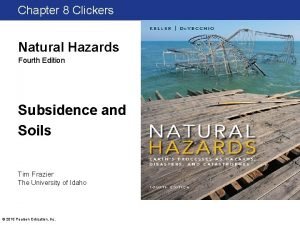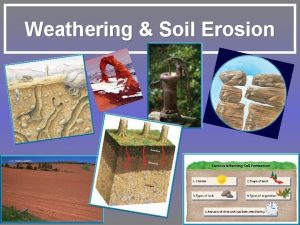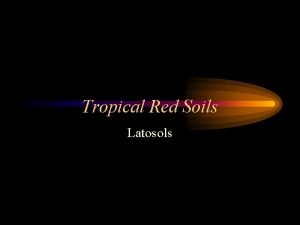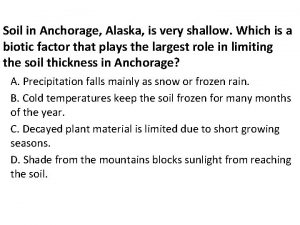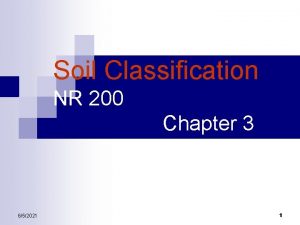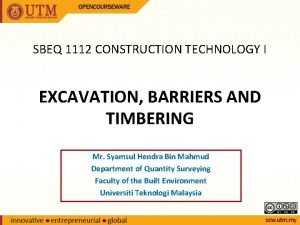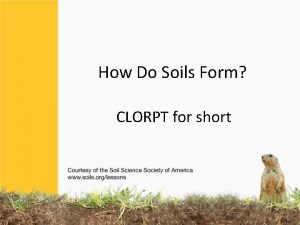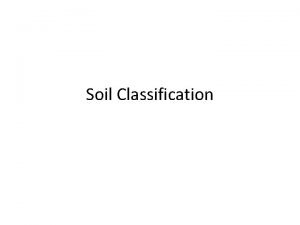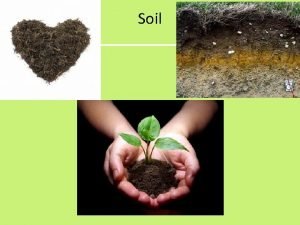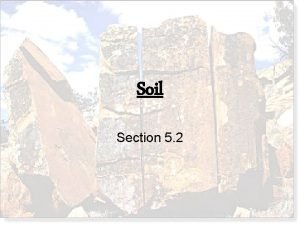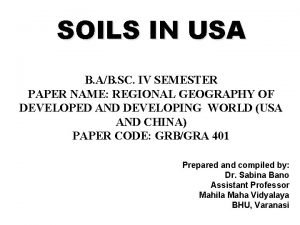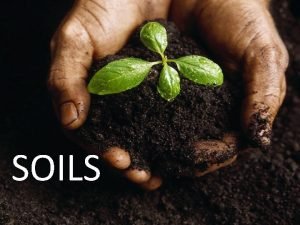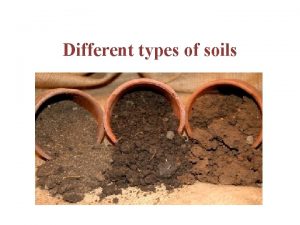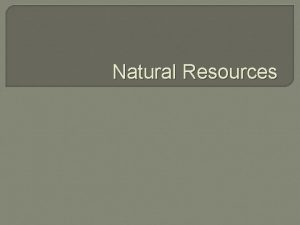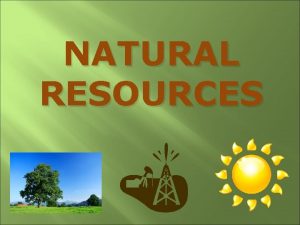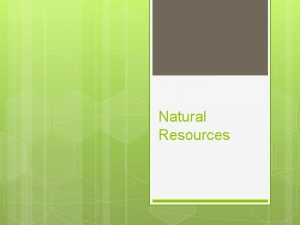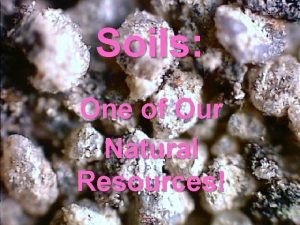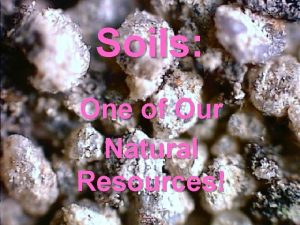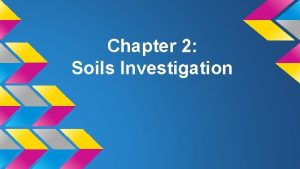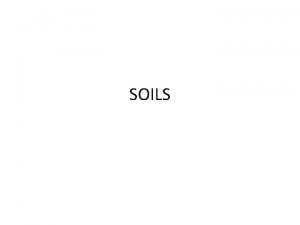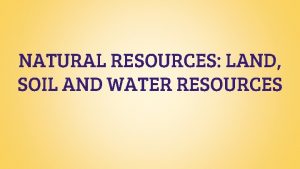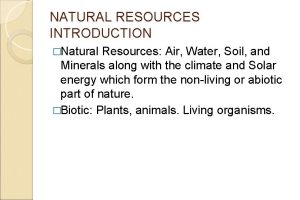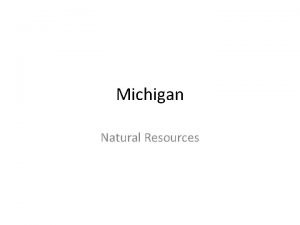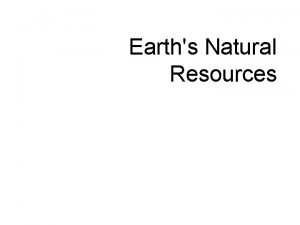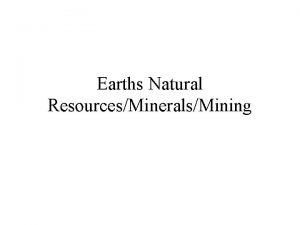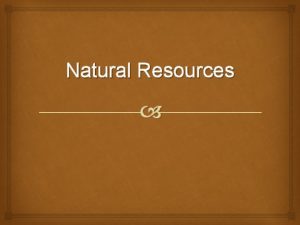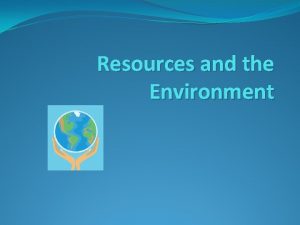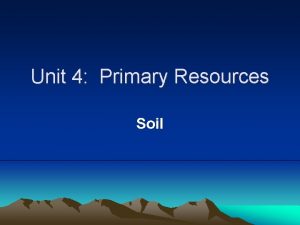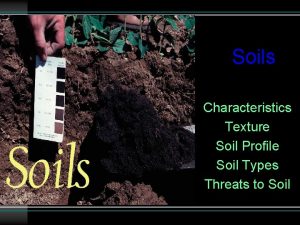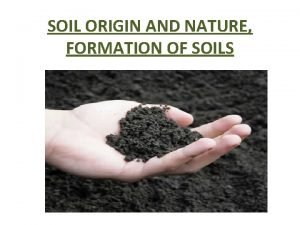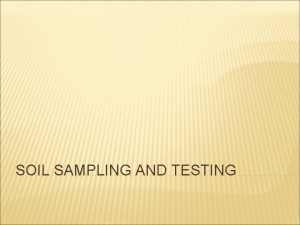Soils One of Our Natural Resources SOIL Soil







































- Slides: 39

Soils: One of Our Natural Resources!

SOIL Soil is made of loose, weathered rock and organic material.

The rock material in soil contains three parts: sand, clay, and silt.

Soil, on the average, consists of 45% mineral, 25% water, 25% air and 5% organic matter. This is just an average!

Important Terms • • • Humus is dark-colored organic matter made-up of decaying pieces of plants & animals. A horizon is a layer of soil. A soil profile is a cross-section of the different soil layers or horizons.

Soil Profile In a cross-section of soil, various zones are formed.

A Horizon: Topsoil This is generally the most productive layer of the soil. Conservation efforts are focused here!

A Horizon: Topsoil • Dark-colored • Topsoil • Most evolved-been around the longest • Contains the most humus • Where the organic matter is

A Horizon: Topsoil This layer is usually loose and crumbly with varying amounts of organic matter.

A Horizon: Topsoil • Leaching is the dissolving of minerals in water & carry down through soil horizons • Leaching occurs primarily in the A Horizon

B Horizon: Subsoils are usually lighter in color, dense and low in organic matter.

B HORIZON • Below the A Horizon • Light colored • Contains minerals leached from A horizon • Very few plant roots here

C Horizon: Transition This layer of transition is almost completely void of organic mater and is made up of partially weathered parent material.

C HORIZON – – – Below B horizon Bottom layer Least evolved No humus Solid rock below (bedrock)

Bedrock Below the C horizon the unweathered bedrock will be found.

There are thousands of different soils throughout the world. Five important factors influence the specific soil that develops.

5 Factors of Soil Development • Parent Material • Climate • Type of organic matter • Topography • Time the soil has been developing

Parent Material This refers to the minerals and organic materials present during the soil’s formation.

Parent Materials from volcanoes, sediment transported by wind, water, or glaciers are some examples.

Question Break!

Think about prairie soil. Where do you think the “parent material” came from?

Climate The climate of a particular region can have a major influence on the rate of soil formation.

Climate Weathering processes like the cycles of freezing and thawing (ice wedging), along with wetting and drying vary with each region.

Climate – The thickness of horizons depends upon climate – Soil horizons are thinner where there is little rainfall

Living Organisms Both plants and animals help create soil.

Living Organisms As they die, organic matter incorporates with weathered parent material and becomes part of the soil.

Question Break!

Can you think of some organisms that might help mix and enrich the soil?

Living Organisms The actions of moles, earthworms, bacteria, fungi, and insects mix and enrich the soil.

Topography The slope or hilliness of a region can have a major influence on the moisture and erosion of soils.

Topography In many regions, moist, poorly drained soils are located in low areas.

Topography Drier, well drained soils are often found in sloping hillsides. Erosion is often a problem here and can lead to lose of topsoil.

Time It takes hundreds of years to form one inch of soil from parent material. Under extremely poor conditions, it can take thousands of years.

Time Only the top few centimeters are productive in the sense of being able to sustain plant growth.

Time This is why soil conservation is so important!

Last Question!

What do you think leads to soil erosion?

Causes of Soil Loss • Caused by: – Overgrazing – Clearing of forests (rainforest) – Poor farming practices “Dust Bowl” happened because of poor farming practices

Ways to Conserve Soil • • Contour plowing Terraces Crop Rotation http: //en. wikipedia. org/wiki/Terracing_(agriculture) Terrace (agriculture) - Wikipedia, the free encyclopedia
 How does the study of soils help evaluate natural hazards?
How does the study of soils help evaluate natural hazards? Weathering and soil erosion
Weathering and soil erosion Tropical red soils
Tropical red soils What is soil?
What is soil? Anchorage soil
Anchorage soil Prairie soils (mollisols) are _______.
Prairie soils (mollisols) are _______. Timbering in dry loose soils
Timbering in dry loose soils Ciorpt
Ciorpt Soil taxonomy definition
Soil taxonomy definition 4 major components of soil
4 major components of soil Soil that forms on unconsolidated deposits is called
Soil that forms on unconsolidated deposits is called Soil layers
Soil layers Forensics
Forensics Pedocal soils
Pedocal soils The transformation process
The transformation process Differentiate fixed resources and variable resources
Differentiate fixed resources and variable resources Renewable vs nonrenewable resources worksheet
Renewable vs nonrenewable resources worksheet Living soil vs dead soil
Living soil vs dead soil What are the four spheres of the earth
What are the four spheres of the earth One god one empire one emperor
One god one empire one emperor One one one little dogs run
One one one little dogs run One king one law one faith
One king one law one faith One empire one god one emperor
One empire one god one emperor One ford behaviors
One ford behaviors See one do one teach one
See one do one teach one One price policy
One price policy One face one voice one habit and two persons
One face one voice one habit and two persons See one do one teach one
See one do one teach one Asean tourism strategic plan
Asean tourism strategic plan Graphic organizer with the aims of la liga filipina
Graphic organizer with the aims of la liga filipina Thinking affects our language, which then affects our:
Thinking affects our language, which then affects our: Our census our future
Our census our future Ok 313
Ok 313 Our life is what our thoughts make it
Our life is what our thoughts make it We bow our hearts
We bow our hearts Our census our future
Our census our future Our life is what our thoughts make it
Our life is what our thoughts make it Money madness is written by
Money madness is written by Awareness of ourselves and our environment is:
Awareness of ourselves and our environment is: Our awareness of ourselves and our environment.
Our awareness of ourselves and our environment.
